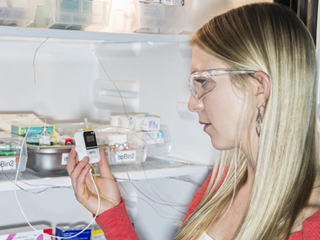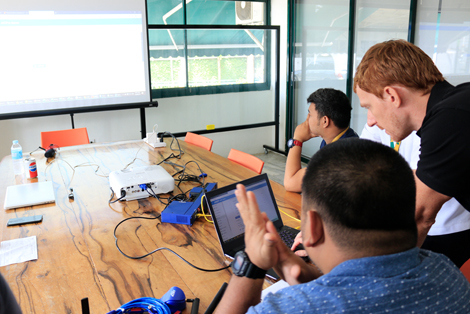The Occupational Safety and Health Administration (OSHA) plays a critical role in ensuring safe and healthy working conditions across American workplaces.
Statistics are staggering, showing on average 1 worker dies on the job every 96 minutes in the USA. Data released by the Department of Labor Statistics (DLS) show a 10 year high, with 6,486 worker deaths, a 5.7% increase from 2021.
OSHA has an extensive set of regulations to address the multitude of hazards in the workplace. From Airborne contaminants, to noise levels, temperature and ergonomics. Traditional methods of compliance involved manual monitoring of these aspects through regular inspections. However, the rise of the digital realm, availability of sophisticated sensors and IoT technology has revolutionized the ways in which workplaces can demonstrate OSHA compliance.
In this blog, we will look at how some of these technologies can be applied, to enable business owners to proactively safeguard workers, and streamline their OSHA compliance efforts.
Navigating OSHA compliance can feel like a daunting task, with their myriad of requirements. Challenges include keeping up to date with the latest mandates, monitoring and reporting requirements, and demonstration of compliance.
The penalties can be severe, with fines, lawsuits and worker injuries that can devastate lives. These are diversions that cost businesses and could ultimately result in closure.
Real-Time Data Acquisition: A Game-Changer for OSHA Compliance
The most significant advantage of utilizing sensor technology for OSHA compliance is the ability to gather real-time data within the workplace. Sensors are strategically placed in the workplace to monitor risks such as :-
- Airborne Contaminants: Dust, fumes, vapors, and gasses pose serious health risks depending on their type and concentration. Sensors can detect these contaminants in real-time, alerting employers to potential hazards before worker exposure becomes a problem.
- Noise Levels: Excessive noise exposure leads to hearing loss, tinnitus, and other health issues. Noise monitoring sensors ensure noise levels remain below OSHA’s permissible exposure limits (PELs). OSHA has a time weighted average (TWA) of 90 dB over an 8 hour shift. When levels are exceeded a monitoring system prompts corrective actions such as providing hearing protection or implementing noise reduction measures.
- Temperature and Humidity: Extreme temperatures and humidity levels are critical health risks. Overexertion in elevated temperatures and humidity lead to fatigue, dehydration and in worst cases, heat stroke. California for example requires workplaces to maintain a temperature of between 68 and 78°F (20 to 25°C). Outside of these temperatures specific regulations, protective equipment or training must be given.
- Illumination Levels: Poor lighting conditions can lead to eye strain, fatigue, and accidents. Light sensors ensure adequate illumination in accordance with OSHA standards for specific tasks and work areas. On the contrary, too might light exposure is also damaging to eyesight, certain frequencies of light also can cause permanent damage.
- Restricted areas: Certain areas within a workplace may be restricted for suitably qualified personnel, or only when specific protective gear is worn or used. Motion sensors can check restricted areas for activity and cameras give visual verification that established health and safety protocols are being adhered to.
Deploying sensors that monitor the above parameters, not only aids in demonstrating OSHA compliance. They provide real time data and alerts that are utilized proactively to identify and address issues before they become violations of OSHA regulations and impact worker health.
AKCP sensor solutions are deployed for such situations. Network enabled wired and wireless sensors that monitor the working environment, log and graph data, create reports and alerts when predefined thresholds are exceeded. Integration of this data with a central monitoring platform via SNMP or MQTT makes this an IoT solution, giving business owners insights no matter where they are located. Ideal for multi site business locations that require a centralized platform that monitors OSHA compliance.
AKCP offers sensors such as the NIST2 and NIST3 temperature sensors. These have built-in sensor calibration checking, alerts when sensors are out of calibration, and in the case of the NIST3 a failover sensor to continue recording. With this kind of technology the accuracy of data is safeguarded.
Proactive Risk Management and Improved Worker Safety
Businesses should not view such a monitoring system as an expense, but rather than asset. Not only does OSHA compliance mitigate the risks of fines and closures, but there are other financial benefits to be made. Reduced compensation claims from workers after accidents, reduced insurance premiums, improved worker health and morale, which leads to increased productivity and reduction in downtime. On a publicity front as well, demonstrating a commitment to Environmental and Social Governance (ESG) protects brand image, and improves investor relations.
By leveraging real-time data from sensors, businesses can implement proactive measures to minimize risks and ensure worker safety in ways such as:
- Early Warning Systems: Sensors programmed to trigger alarms or alerts when environmental factors exceed safe limits. This allows for immediate corrective actions, such as evacuating workers from a contaminated area or shutting down noisy equipment.
- Data-Driven Decisions: Continuous data collection allows employers to identify trends in environmental conditions. This information can be used to optimize ventilation systems, schedule maintenance activities for equipment, and adjust work practices to minimize exposure to hazards.
- Improved Training Programs: Identify areas where workers need additional training on safe work practices and proper use of personal protective equipment (PPE).
These proactive measures not only enhance compliance but also demonstrate a strong commitment to worker safety, fostering a positive work environment and potentially reducing the risk of worker injuries and illnesses.
Case Study
Here’s an example of how sensors were deployed in a textiles factory. A temperature and humidity monitoring system was installed to determine hot zones, areas of the workplace that were close to, or exceeding the mandated working temperatures. To ensure that the conditions were safe for workers to operate, large fans with evaporative cooling were installed in the areas deemed to be too hot. In addition, ventilation was adjusted to improve natural airflow through the facility and bring about natural cooling.
Through this system a 20% reduction in heat related incidents, sickness and absences were recorded. Improved health of workers, improved productivity and less risk of government compliance intervention made it a win-win for the business.
The success was further enhanced by the installation of power meters and control systems that would automate the fans and cooling system as required. This resulted in a 5% reduction in the energy used.
Streamlining OSHA Compliance Processes
The data collected by sensors significantly streamlines the OSHA compliance process. Here are some key benefits:
- Reduced Reliance on Manual Methods: Sensors offer a more efficient and accurate alternative to manual monitoring. This reduces the burden on safety personnel and allows them to focus on more strategic tasks.
- Detailed Documentation: Sensor data provides a continuous record of environmental conditions within the workplace. This data can be used to demonstrate consistent compliance with OSHA regulations during inspections.
- Improved Communication and Collaboration: Real-time data from sensors can be readily shared with all stakeholders, including safety officers, managers, and workers. This facilitates collaboration on safety initiatives between departments and staff.
By leveraging sensor technology, businesses can shift their compliance focus from reactive inspections to ongoing monitoring. This not only simplifies the process but also positions the company as a responsible and safety-conscious employer.
The Future of Sensor Technology in OSHA Compliance
The continual advancements in sensor technology are constantly expanding its role in OSHA compliance. Emerging trends include:
- Wireless Sensor Networks: Wireless sensor technology makes for easy installation in the workplace. For retrofits and areas that cables or power are not easily available. AKCP leverages LoRa radio hardware with their own proprietary Wireless Tunnel™ protocol. This provides reliable communications up to several kilometers in open space, and battery life of up to 10 years.
- Wearable Sensors: These sensors can be worn by workers to monitor individual exposure levels to specific hazards, providing a personalized monitoring experience. This is similar to those working in nuclear environments where an individual’s exposure to radiation is measured. With the latest sensor technology a multitude of environmental conditions can be monitored.




